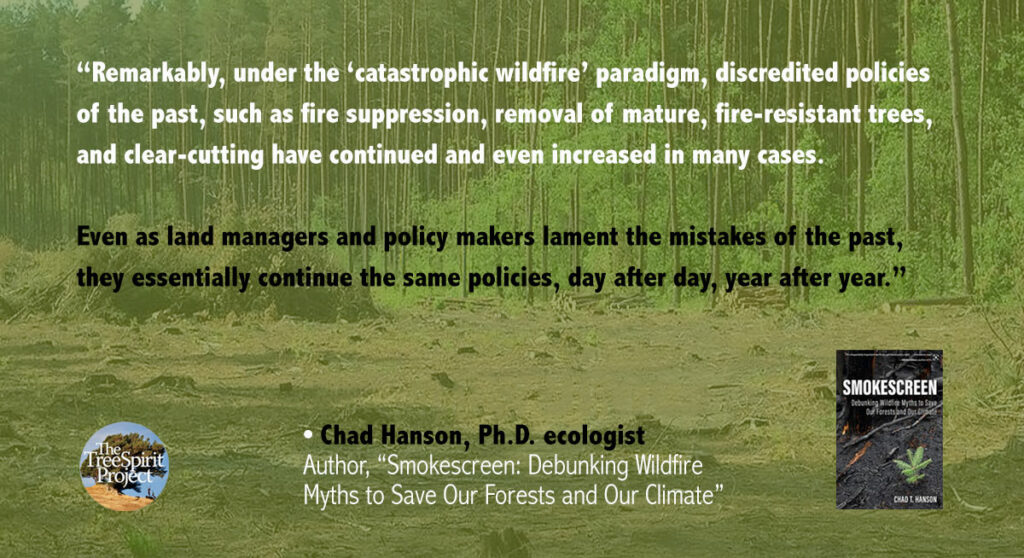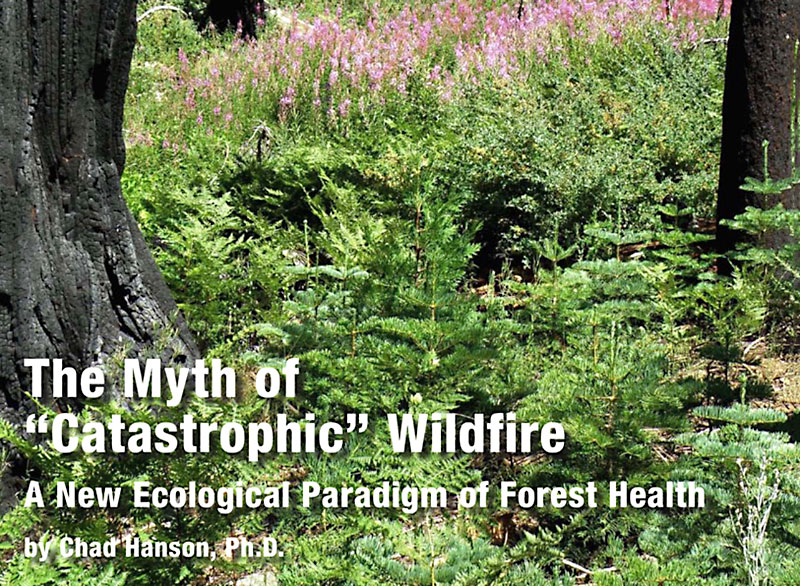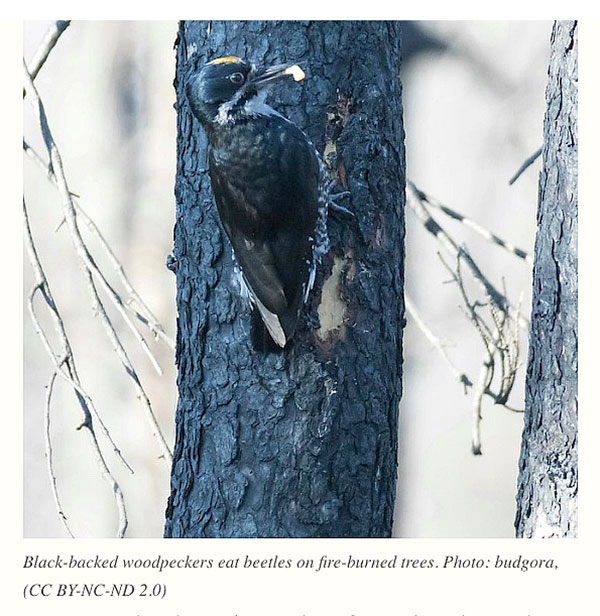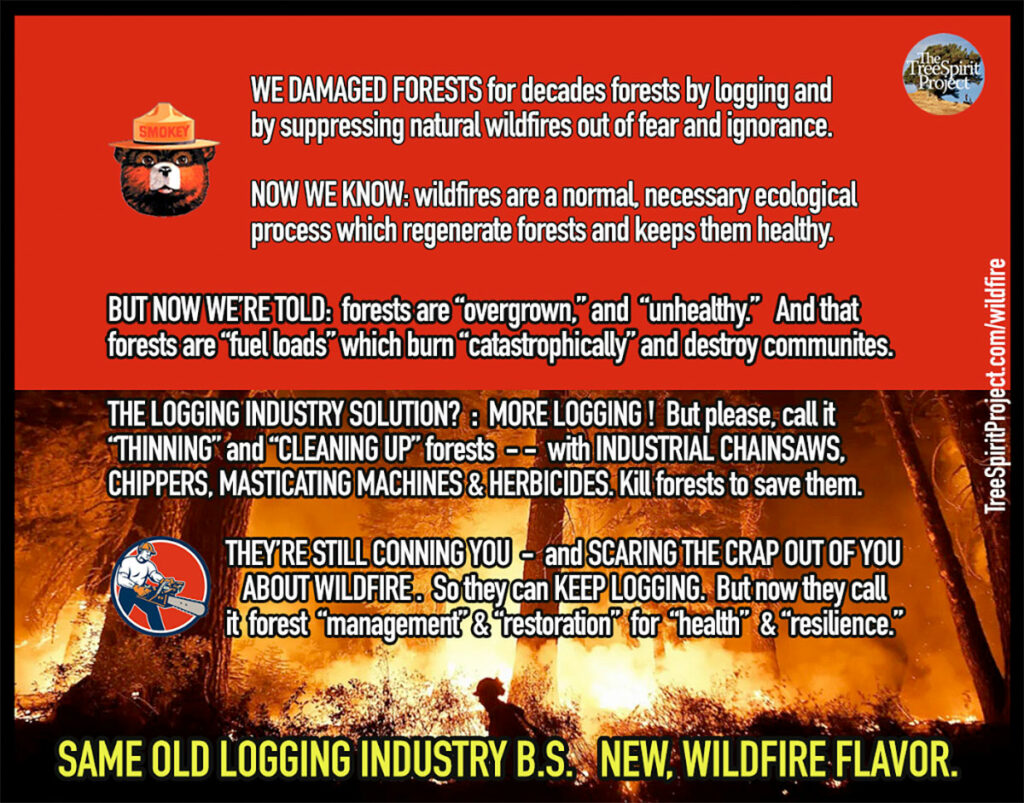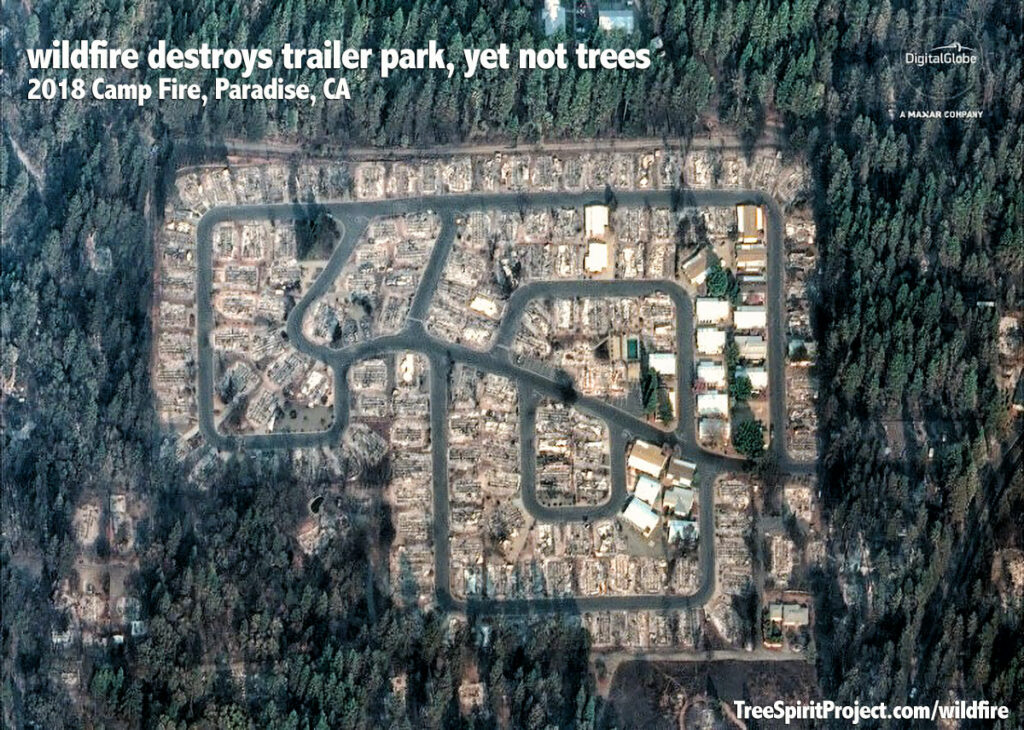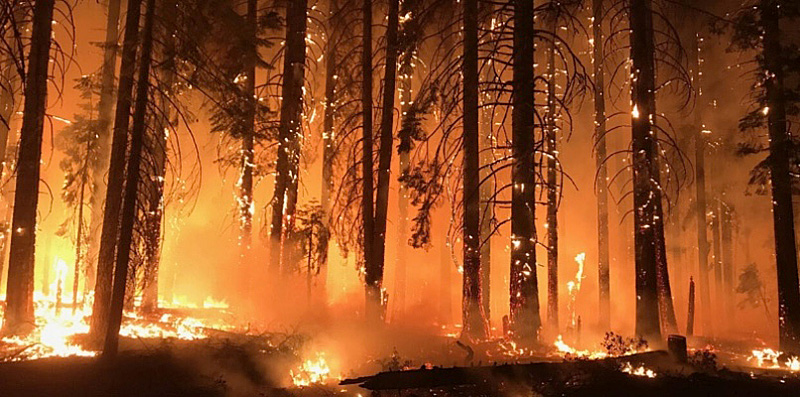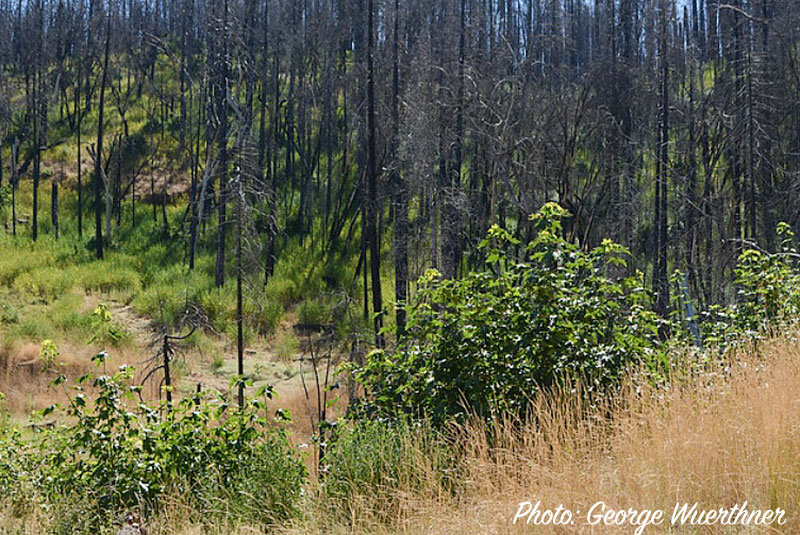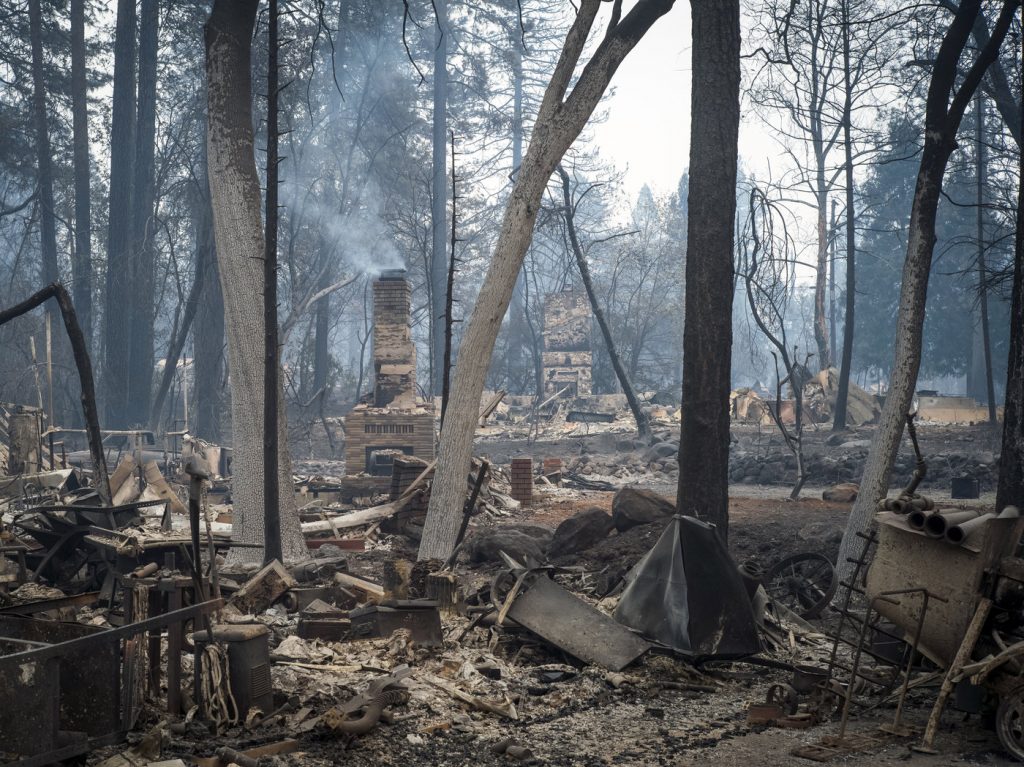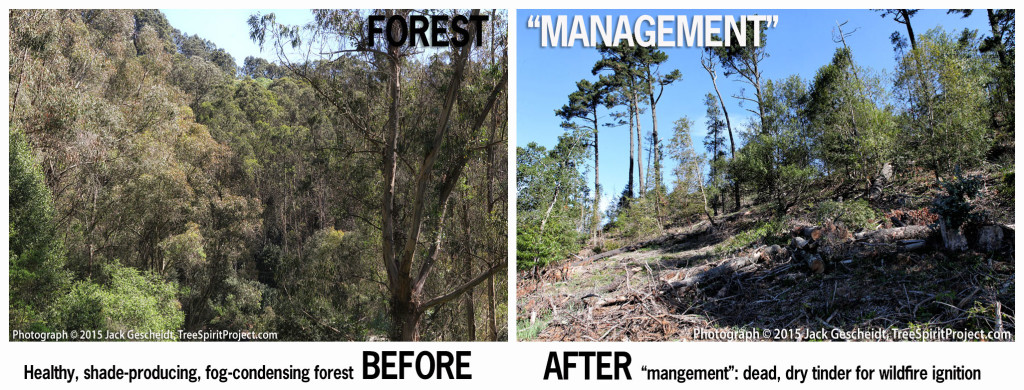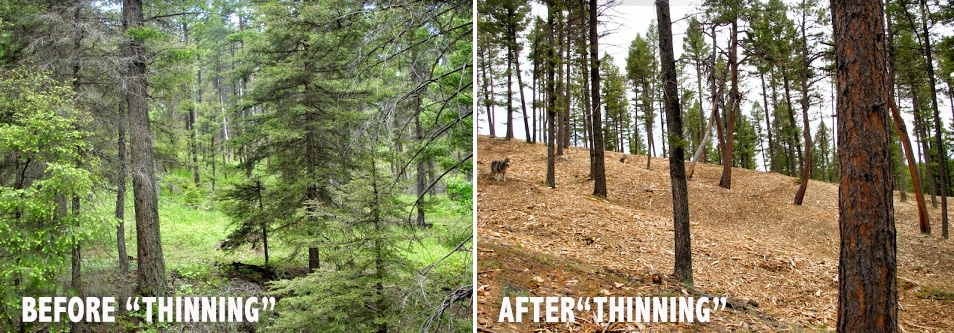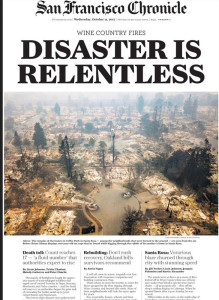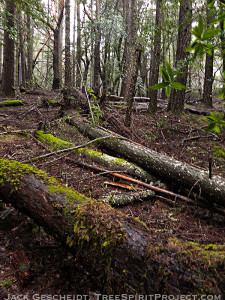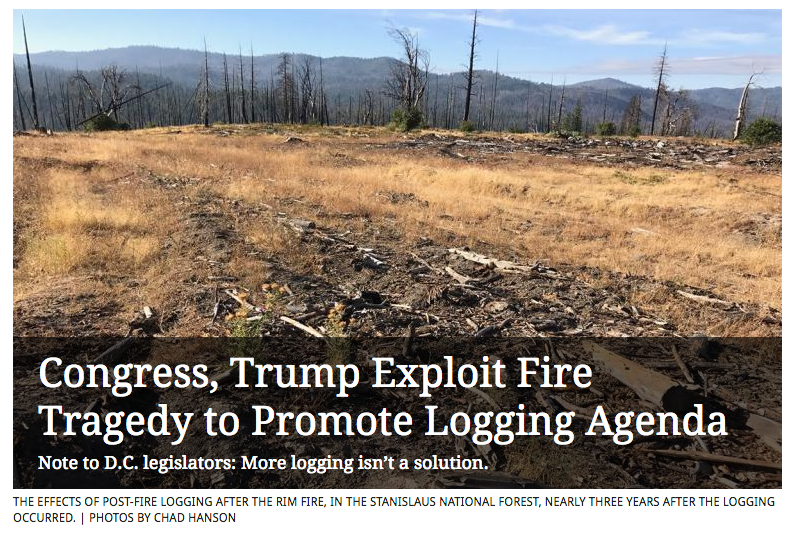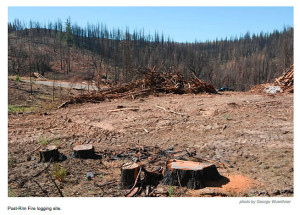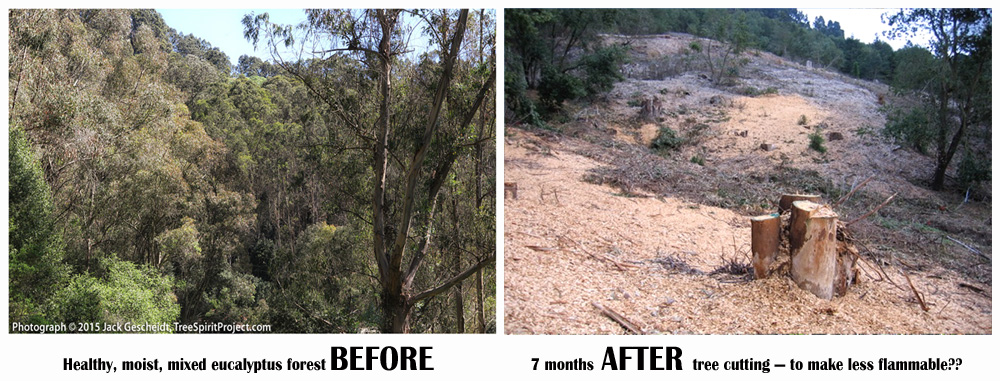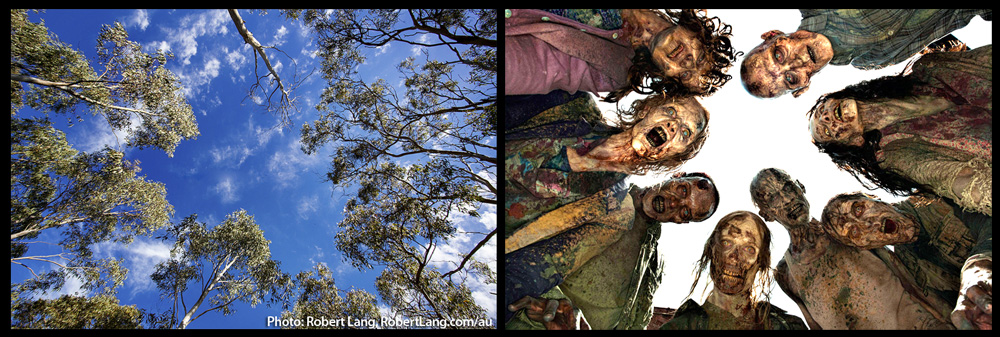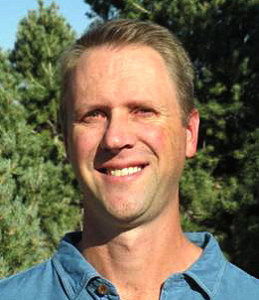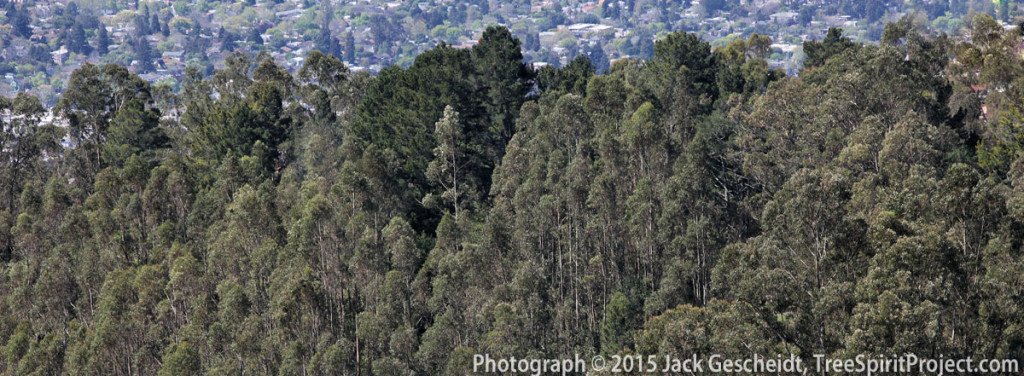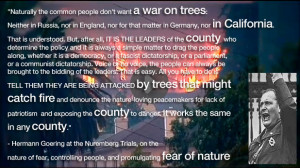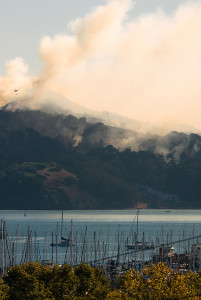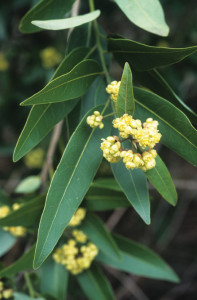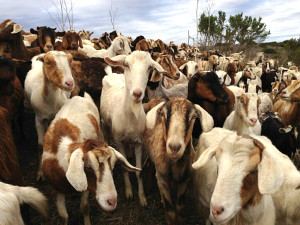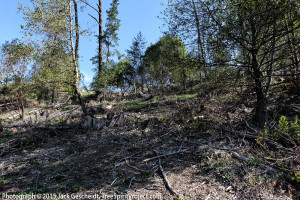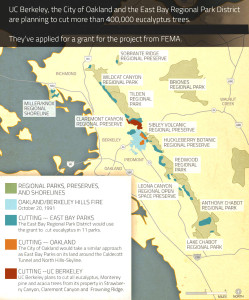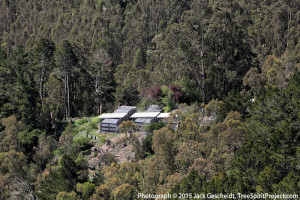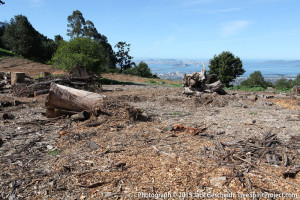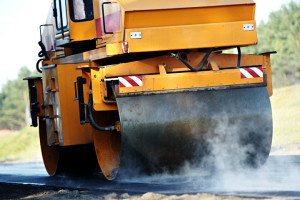MYTHS, MISINFORMATION — and DISINFORMATION
Stoking fear of “catastrophic wildfire” to justify “thinning” (aka, logging) harms forests. And increases wildfire danger.
The central message of Smokescreen, the latest book (2021) by ecologist Chad Hanson, Ph.D., is that the U.S. Forest Service, the timber industry and its allies, amplified by unwitting media outlets, are fearmongering with misinformation to justify continued logging of publicly-owned forests. Euphemisms including “thinning” and “treating” and “managing” and “fuels reduction” all describe deforestation. They central lie, now commonly accepted by a mislead public is the scientifically false claim that cutting down trees reduces the risk of so-called “catastrophic” wildfires. Hanson’s book, packed with studies, debunks this false claim head on.
The latest scientific research, detailed in numerous forest studies, reveals that forests that have not been logged (“managed” or “thinned”) burn with less intensity than forests that have been logged. And that logging releases more atmosphere-heating carbon than wildfires do, especially since newly-burned forests quickly begin storing carbon again, while post-fire or “salvage” logging inhibits forest regeneration.
“Thinning” and “managing” forests — euphemisms for logging — damages forest health and increase wildfire danger.
The current populist push for increased logging is being done under the guise (hence, smokescreen) of wildfire mitigation. The real catastrophe is not wildfire, but using fear and misinformation about “catastrophic wildfire” to justify logging (“thinning” and “treating”) healthy forests and wildlife habitat… which accelerates the climate crisis by destroying the vital carbon sinks and healthy, damp, wildfire-resistant forest floors of unmanaged forests.
It’s understandably difficult to accept — due to decades of ecological misunderstanding and misinformation — but wildfires are both unavoidable and essential for healthy forests, and healthy ecosystems and that
Now commonplace and widespread, forest “management” projects to “reduce the fuel load” of “overgrown forests” (yet another myth) in reality compact and damage healthy forest soil, reduce cooling forest canopy, dries out forest floors, and even increases winds which drive wildfires, increasing the likelihood of higher-intensity fires.
Put simply, previously unlogged and older-growth forests are more wildfire-resistant than “managed,” logged and “thinned” forests. They are precious resources we must today protect, not manage to death, and to our own detriment.
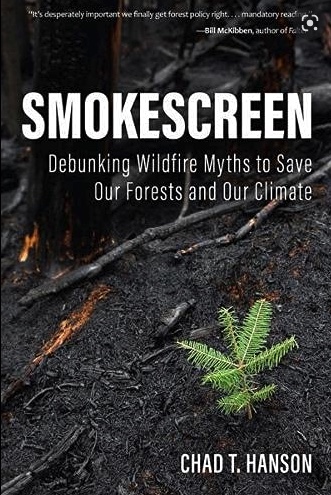 SMOKESCREEN: Debunking Wildfire Myths to Save Our Forests and Climate
SMOKESCREEN: Debunking Wildfire Myths to Save Our Forests and Climate
Worried your neighborhood trees and forests pose a fire danger to you? — but don’t relish the idea of cutting them down, or watching idly as utility companies like California’s PG&E (Pacific Gas & Electric) destroy millions of trees unnecessarily?
Chad Hanson, Ph.D. forest & wildlife researcher and director of The John Muir Project with Earth Island Institute of Berkeley, CA, explains key conclusions from decades of wildfire research which challenge common myths and misinformation spread by the logging industry, the U.S. Forest Service, and the media’s stories of “catastrophic” wildfires — and what causes them.
One key takeaway: “Thinning” forests — a euphemism for cutting down up to 1/3rd of the trees in a forest — won’t make your house safe from wildfire. Instead, “harden” your home to make it ignition-resistant.
EXCERPT (from publisher, University Press of Kentucky):
“Smokescreen cuts through years of misunderstanding and misdirection to make an impassioned, evidence-based argument for a new era of forest management for the sake of the planet and the human race. Natural fires are as essential as sun and rain in fire-adapted forests, but as humans encroach on wild spaces, fear, arrogance, and greed have shaped the way that people view these regenerative [wildfire] events and given rise to misinformation that threatens whole ecosystems as well as humanity’s chances of overcoming the climate crisis.
Scientist and activist Chad T. Hanson explains how natural alarm over wildfire has been marshaled to advance corporate and political agendas, notably those of the logging industry. He also shows that, in stark contrast to the fear-driven narrative around these events, contemporary research has demonstrated that forests in the United States, North America, and around the world have a significant deficit of fire.”
VIDEO: Must-see viewing for anyone worried about wildfire.
And skeptical about “managing” forest health with chainsaws, bulldozers and herbicides.
 Debunking the Biggest Myth About Wildfires
Debunking the Biggest Myth About Wildfires
A new book explains why misunderstanding fire is dangerous for communities, wildlife and fighting climate change.
By Tara Lohan, May 26, 2021
EXCERPTS:
“People have this tendency to think about fire in the forest in the same way they think about fire affecting their home. If their home burns, that’s devastating. And therefore, they think if a fire burns in the forest that must also be devastation. So they want solutions from policymakers. They want people to tell them that they’re going to fix the problem out there somewhere in the forest.
…we need to fundamentally shift that perception so that people understand that fire is a natural and beneficial ecological force out in the forest.
We actually have a deficit of fire in almost every forest ecosystem relative to natural pre-suppression levels. The real losses and harms that are happening in communities are almost entirely preventable if we focus our resources and attention near homes, but it’s going to take a 180-degree shift in direction from our current policies.”
“And it’s not just fire that burns at low intensity and creeps along the surface. Some species like that just fine, but others like it hot and they need the areas where fire burns more intensely and kills most, or all, the trees in patches.”
READ The Revelator article: https://therevelator.org/myths-wildfires-hanson
Stop With The “Catastrophic Wildfire” Scare Tactics
‘Catastrophic wildfire” is an alarmist, politically driven catchphrase with little scientific credibility.
By Jimmy Tobias, August 15, 2017
EXCERPTS:
“The term catastrophic wildfire is scientifically bankrupt, there is no question about it,” says Chad Hanson, a research ecologist and fire expert with the John Muir Project in California. “It has no scientific credibility.”
“It is a political and economic term,” he adds, a “cudgel” used by politicians and interest groups to frighten people into supporting policies (like the Resilient Federal Forests Act) that are not in the public interest.
What’s more, it’s not at all clear that wildfires have become more severe, or more “catastrophic” in recent years, as popular narratives might suggest. Hanson, for instance, points to a peer-reviewed paper published by The Royal Society in 2016 that found little indication that fires have become more severe in the American West.”
Even when fires do burn hot, even when they ignite canopies and sweep through large swaths of forest, they are often highly beneficial from an ecological standpoint.
“What hundreds of studies show is that patches of high-intensity fire creates one of the most ecologically important and biodiverse habitat in our forests, it creates snag forest habitat,” Hanson says. “That habitat type is comparable in terms of wildlife abundance and native biodiversity to old growth forest. It is incredibly vibrant.”
READ Pacific Standard article: ‘https://psmag.com/environment/a-catastrophic-scare-tactic
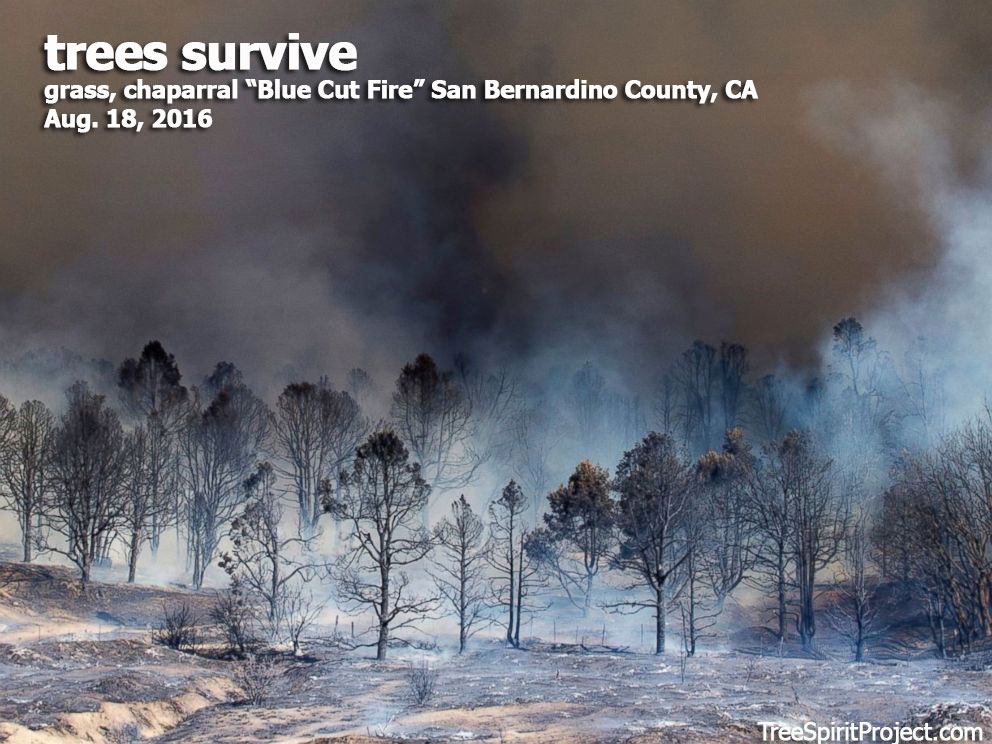
WILDFIRE IS INEVITABLE & NECESSARY FOR HEALTHY FORESTS
Today’s researchers are restoring wildfire’s proper place in our understanding as essential and environmentally beneficial. New forest science echoes ancient knowledge of wildfire’s integral role in sustaining healthy wildlands for plants, animals — and humans. Fire is an evolutionarily designed and functional force at work long before humans appeared on the scene. It clears smaller vegetation, activates the seeds of trees to germinate, and readies soil for those seeds to grow. Fire is of net benefit — even accounting for anthropogenic climate change.
![]() Wildfires & Climate Lies: On the Myth of the “Tidy Forest”
Wildfires & Climate Lies: On the Myth of the “Tidy Forest”
Why We Need Our Old, Messy Woods – May 27, 2021
EXCERPT:
“…demonizing forest fires and spreading sensational, spurious myths about them fundamentally undermine solutions to the climate crisis by keeping the focus on efforts to “stop” fires and “manage” forests ostensibly to prevent future fires. This not only fails to stop natural fires driven primarily by weather and climate but also diverts scarce resources away from creating fire-safe communities.
Worse still, it results in even more logging of forests—an outcome that increases carbon emissions overall, exacerbating climate change. And ironically, logging often increases fire intensity, in addition to fragmenting habitat and threatening imperiled wildlife—all at a time when we need to increase forest protection to mitigate climate change and save endangered species, while directing resources toward adaptation measures such as creating fire-safe communities.
READ ARTICLE: https://lithub.com/wildfires-and-climate-lies-on-the-myth-of-the-tidy-forest
“THINNING” FORESTS — i.e., CUTTING DOWN TREES — DOES NOT REDUCE WILDFIRE DANGER
As people increasingly build houses and other structures closer to forests, or in them, a destructive misconception is spreading: that forests pose a danger and require “management” and “maintenance” and so-called “thinning” — now often euphemisms for logging practices, to ensure public safety. Cutting down trees, including healthy living trees, by labeling them “dying”, “diseased” or “hazardous” makes logging sound reasonable and necessary.
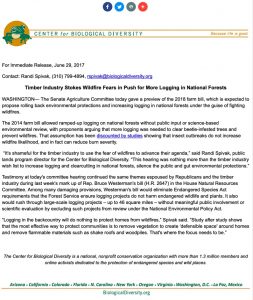 Exploiting public fear of wildfire to justify cutting down more trees and forests advances the agenda of timber companies to increase logging and profits, and actually INCREASES the likelihood of fast-moving, wind-driven ground fires, the kind making 2018-19 headlines in both Northern and Southern California.
Exploiting public fear of wildfire to justify cutting down more trees and forests advances the agenda of timber companies to increase logging and profits, and actually INCREASES the likelihood of fast-moving, wind-driven ground fires, the kind making 2018-19 headlines in both Northern and Southern California.
READ Press Release: “Timber Industry Stokes Wildfire Fears in Push for More Logging in National Forests.
In addition to the timber industry, developers and “nativists” who want to eradicate entire species of trees and plants often advocate “clearing” or “managing” forests. This can mean many things, from killing forest floor ground cover plants, including oft-targeted species like thistle, broom, ivy, and blackberry. This denudes and harms a forest in numerous ways, including drying out a forest, reducing critical wildlife habitat already on the decline from urbanization, and even applying toxic herbicides.
Tragically, these destructive forestry practices are used widely today, even, e.g., by supposedly environmentally aware cities in the San Francisco Bay Area: READ WHERE & WHY
The quotations used in the terms above are added to indicate that the terms “management,” maintenance,” “thinning,” “invasive,” “non-native,” “native” and “noxious” and even the venerable “weed” are misnomers. They are non-scientific terms. They are euphemisms designed to mislead the public into thinking these actions are mild, appropriate, or helpful, when they are almost always not. For example, “thinning” now often refers to cutting down 2/3rds of the trees in a forest. Even the U.S. Forest Service has adopted some of these environmentally destructive practices, largely from direct timber industry influence or indirectly through their influencing politicians.
• READ MORE: https://deepgreenresistancesouthwest.org/stop-thinning-forests/
DON’T CUT DOWN TREES, FIREPROOF HOUSES
Another popular, harmful practice is trying to make houses safe from wildfire by “managing” and “thinning” the surrounding or nearby forests — CUTTING DOWN  TREES and VEGETATION and removing BRUSH over 100 feet away from the house — instead of building and preparing houses to be more ignition-resistant. 90% of wildfire fire home ignitions are caused by airborne embers from fires over 100 feet away. Making houses ignition-resistant is the recommended approach by today’s fire scientists and agencies. In fact, deforestation is NOT only ineffective, it can INCREASE the chances of home ignition. Trees are fire-suppressing windbreaks, and block the heat of a wildfire, that can ignite houses. Witness all the massive, recent California wildfires that occurred in grasslands — and in forests that had been “managed.”
TREES and VEGETATION and removing BRUSH over 100 feet away from the house — instead of building and preparing houses to be more ignition-resistant. 90% of wildfire fire home ignitions are caused by airborne embers from fires over 100 feet away. Making houses ignition-resistant is the recommended approach by today’s fire scientists and agencies. In fact, deforestation is NOT only ineffective, it can INCREASE the chances of home ignition. Trees are fire-suppressing windbreaks, and block the heat of a wildfire, that can ignite houses. Witness all the massive, recent California wildfires that occurred in grasslands — and in forests that had been “managed.”
“Prevent fires from the house out, rather than the wildland in.” These words from The California Chaparral Institute capture the shift that is needed in the state’s approach to wildfire management and prevention. California’s wildfires are a dire concern. Also concerning, however, is the ongoing effort to address these wildfires by removing vegetation rather than making buildings less vulnerable to fire.”
– Amy Murre, Wildfire Protections from Homes
 No, California’s Forests Aren’t Failing to Regrow After Big Wildfires
No, California’s Forests Aren’t Failing to Regrow After Big Wildfires
The post-fire snag forest is some of the rarest and shortest lived habitat in our forest ecosystems.
EXCERPTS:
“…context is important because most current management, including so-called forest restoration, is justified on the belief that human inference with natural processes has created current forest conditions, and thus requires human intervention, usually in the form of logging.”
“And while California has experienced some large wildfires with extensive high-severity patches, one shouldn’t ignore the fact that the state has experienced one of the longest and most extreme droughts in the past 1,000 years. Given such historic drought conditions, one would expect there to be significant wildfires.”
“And when considering the climate change context, it would help to look at wildfires (as well as other natural processes like bark beetles) as helping to thin forests to help them adjust to new climatic parameters. The lack of conifer regeneration may be viewed as a good thing that is balancing the vegetation’s hydrological needs with available soil moisture.”
“In fact, in many instances, it is standard Forest Service practice in the Sierra Nevada and elsewhere to use herbicides on these nitrogen-fixing shrubs to hasten the establishment of conifers, therefore short-circuiting the natural ecological succession, and reducing the replacement of important nutrients in the soils.”
“Furthermore, the researchers own data showed there was less conifer regeneration on drier sites — exactly what one would expect during a severe drought that only exacerbates seedling failures.”
“Another important value of high-severity blazes that was not mentioned in the report is that they introduce snags and dead wood into forest ecosystems. The post-fire snag forest is some of the rarest and shortest lived habitat in our forest ecosystems. Studies have demonstrated that such snag forests — which include patches of native fire-following shrubs, downed logs, colorful wildflowers, and dense pockets of natural conifer and oak regeneration — are among one of the most biodiverse forest ecosystems. These short-lived forests exist only for a few years until the regeneration process is complete and new trees start taking over the space.”
READ Jan. 5, 2017 Earth Island Journal ARTICLE
by George Wuerthner:
Using Wildfires as an Excuse to Plunder Forests
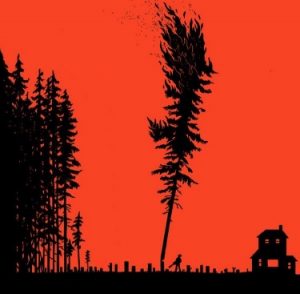 Logging won’t end the blazes that are sweeping the West.
Logging won’t end the blazes that are sweeping the West.
“The danger from wildfires is real, but cutting down more trees is not the solution. By far the most effective way to prevent damage is to focus on basic fire-safety measures for at-risk houses. These include installing fire-resistant roofing, ember-proof exterior vents and guards to prevent wind-borne embers from igniting dry leaves and pine needles in rain gutters and creating “defensible space” by reducing combustible grasses, shrubs and small trees within 100 feet of homes. Research shows these steps can have a major impact on whether houses survive wildfires.”
HOW TO PROTECT YOUR HOUSE FROM WILDFIRE.
For all those living in dryer regions of the U.S. — incl. California, Arizona, Nevada — who feel more threatened by wildfire than ever before…
Fire scientist Jack Cohen, Ph.D., a career fire scientist with the US Forest Service, explains how to make your house safer from wildfire.
WATCH THIS crucially helpful video about making your house “Ignition Resistant.”.
More videos about Cohen’s valuable work — and valuable information for homeowners — are farther down this page.
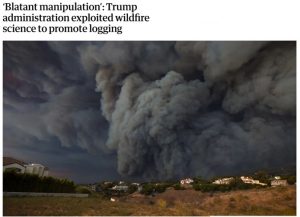 ‘Blatant manipulation’: Trump Admin. exploited wildfire science to promote logging
‘Blatant manipulation’: Trump Admin. exploited wildfire science to promote logging
The Guardian, Jan. 24, 2020
“…Trump and his appointees have tried to craft a narrative that forest protection efforts are responsible for wildfires, including in California, even as science shows fires are becoming more intense largely because of climate change.”
READ MORE.
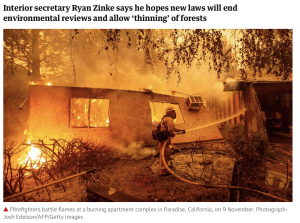 “Trump officials accused of using deadly wildfires to boost logging.”
“Trump officials accused of using deadly wildfires to boost logging.”
The Guardian, Nov. 28, 2018
“…the [Trump] administration, led by Trump, who has blamed “gross mismanagement of the forests”, was using the fire to pave the way for more logging on federal land, with potentially disastrous results.”
READ MORE.
“Wildfire Protections for Homes”
by Amy Murre, The Sierra Club: https://www.sierraclub.org/california/cnrcc/wildfire-protections-for-homes
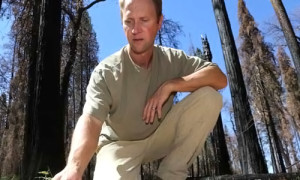 • READ “President Trump is wrong about wildfire prevention”
• READ “President Trump is wrong about wildfire prevention”
by Chad Hanson, Ph.D. fire ecologist, founder of the John Muir Project
Nov. 17, 2018
EXCERPT: It is deeply troubling that Trump and his administration would support logging as a way to curb fires when studies have shown it’s ineffective. In the most comprehensive scientific analysis conducted on the issue of forest management and fire intensity — which looked at more than 1,500 fires on tens of millions of acres across the Western United States over three decades — we found that forests with the fewest environmental protections and the most logging actually tend to burn much more intensely, not less. [Emphasis added – TreeSpirit]
President Trump is wrong about wildfire prevention.
By Chad Hanson, Ph.D., ecologist, Director of The John Muir Project
EXCERPTS:
In the most comprehensive scientific analysis conducted on the issue of forest management and fire intensity — which looked at more than 1,500 fires on tens of millions of acres across the Western U.S. over three decades — we found that forests with the fewest environmental protections and the most logging actually tend to burn much more intensely, not less.
This may seem counterintuitive, but logging leaves behind combustible twigs and branches on the forest floor, which can make fires spread faster. It also reduces the cooling shade of the forest canopy, which creates hotter and drier conditions, and the invasive weeds that take over readily burn. Denser forests buffer and reduce the winds that drive wildland fires, but this effect is largely eliminated by logging.
READ CNN ARTICLE: https://www.cnn.com/2018/11/17/opinions/president-trump-is-wrong-about-wildfire-prevention-hanson/index.html
Forest ‘restoration’ rule is ruse to increase logging
By Chad Hanson, Jan. 31, 2018
EXCERPT:
The Forest Service has now begun promoting the notion that the 257,000-acre Rim Fire emitted about 12 million tons of CO2, based on a computer model that makes the mythological assumption that trees are essentially vaporized during fires. This is part of the “catastrophic wildfire” narrative that the Trump administration has weaponized to argue for rollbacks of environmental laws, and more commercial logging.
In fact, even in the most intensely burned patches, only about 2% of the total biomass of trees is actually consumed.Don’t be fooled. Trump’s proposal is nothing more than a thinly veiled attack on our national forests for the benefit of the logging industry.
READ ARTICLE: https://www.sfchronicle.com/opinion/openforum/article/Forest-restoration-rule-is-ruse-to-increase-12541558.php
Chad T. Hanson is director of the John Muir Project (www.johnmuirproject.org), author of “The Ecological Importance of Mixed-Severity Fires: Nature’s Phoenix” (Elsevier, 2015).
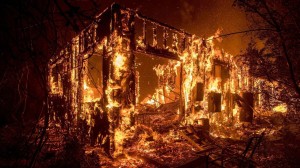 December 7, 2017
December 7, 2017
“Why are California’s homes burning? It isn’t natural disaster, it’s bad planning.”
by Richard Halsey, L.A. Times:
http://beta.latimes.com/opinion/op-ed/la-oe-halsey-socal-fires-why-20171207-story.html
EXCERPT: Agencies like Cal Fire need to begin addressing the question, “How do we protect lives and property?” rather than “How can we stop a wildfire?” Right now, Cal Fire is focused on the latter, with its misguided Vegetation Treatment Program. A focus on the former… would mean spending as much time and money on helping people retrofit homes as on vegetation treatments.
WILDFIRES RENEW & RESTORE LIFE
VIDEO: “The Fire Paradox”: “The more we try to remove fire, the worse we make it.” – Mark Finny, research forester with the U.S. Forest Service.
Wildfire is a powerful, primal force, and an integral, healthy, unavoidable component of a natural forest ecosystem. But we have a complex relationship with this force of nature, especially today with wildland fires near houses, towns and cities that have encroached on dwindling forests, open space, and other wildlands.
VIDEO: Forest Service “Fire Lab” with researchers Jack Cohen, Mark Finney, others.
MISINFORMATION & MISCONCEPTIONS spread like wildfire
Many people have been conditioned, especially by sensationalized media coverage, to label all wildfires as purely “destructive” and “disasters” that “destroy” and must always be extinguished—and prevented. Until recently, even contemporary scientists supported this inaccurate, negatives-only view.
CUTTING DOWN A FOREST TO “SAVE” IT
So-called forest “thinning” actually INCREASES fire danger. And destroys forest health. Numerous hidden agendas propel the terrifyingly widespread policy of cutting down trees, advanced by falsely claiming cutting down 1/4-1/2 the trees in a forests “helps” it, or “reduces the fuel load” as a fire danger reduction measure.
MEDIA SENSATIONALISM STOKES WILDFIRE FEAR
News outlets typically cast forest fires as villains that “destroy” everything in their wake, including forests, and therefore must be prevented. And of course wildfires can do great harm, destroy peoples’ homes and taking lives, as in huge California wildfires in October, 2017. But fires also regenerate a healthy forest ecology, clearing brush, opening seeds with their heat, making tree and plant germination possible. Which means forest fires are indispensable.
Research ecologist Chad Hanson’s article (below) is exemplifies the latest fire science explaining how we can have it both ways: understanding and accepting and more effectively preparing for wildfires, while also saving lives, protecting homes and structures.
ARTICLE: “In Praise of Dead Trees,” by George Wuerthner, Dec. 24, 2018
https://www.counterpunch.org/2018/12/24/in-praise-of-dead-trees
Read why dead trees are signs of a HEALTHY forest, and a lack of dead trees (aka, snags) a sign of an unhealthy one.
EXCERPTS: Like most people I once viewed dead trees as an indicator of some presumed problem in the forest—that a ‘healthy” forest was one with a minimum of dead trees and largely free of wildfire, insects, and disease.
I now understand that large numbers of dead trees are critical to functioning forest ecosystems and sometimes, at the risk of hyperbole, I occasionally say they are ultimately more important to forest ecosystems than live trees.
Sierra Magazine article, by Chad Hanson, Nov. 14, 2017
It’s frustrating, then, to watch Republican leaders in Congress and the Trump administration politicizing the recent tragedy as they push for a sweeping elimination of environmental laws on our national forests and other federal public lands to increase logging and backcountry fire suppression under the guise of community protection.
The fires that occurred last month in California were in low-elevation foothill ecosystems dominated by oak woodlands and grasslands. The fires were far away from any national forests or other federal public lands. Eviscerating environmental laws on federal forestlands would do nothing whatsoever to help the affected communities…. Instead…focus on directly protecting homes and lives from wildland fire. The science is clear on how best to do this, and it involves a few basic steps. Most important, we need to help homeowners make their homes far more fire-safe. This includes measures such as using fire-resistant roofing and siding, installing rain gutter guards (…prevent flaming embers from landing in a dry bed of pine needles and leaves… in rain gutters); using a fine-wire mesh on exterior vents to prevent embers from floating into interior spaces like attics; and replacing wood decks with fire-resistant composites… create “defensible space” within 60 to 100 feet around their homes…
Forests in the American West have been shaped by fires. So why do we continue to fight them?
By George Wuerthner
http://www.earthisland.org/journal/index.php/eij/article/the_war_against_wildfire
EXCERPT: On my way up to Stanislaus National Forest earlier in the day, I’d stopped by a ranger station in Tuolumne County and picked up a printed tour guide for the Rim Fire. The guide cited several reasons for logging the burned areas,  including the usual assertions that fallen trees create a tremendous fuel load that can feed future fires and that the Forest Service was improving visitor safety by removing snags which “posed a significant hazard to forest travelers.”
including the usual assertions that fallen trees create a tremendous fuel load that can feed future fires and that the Forest Service was improving visitor safety by removing snags which “posed a significant hazard to forest travelers.”
Hanson has some choice words when I read this out to him: “Pure bullshit!” His colorful exclamation is, in fact, backed by a ton of research that shows that dead trees – whether killed by wildfire or beetles – tend to reduce future fires, not enhance them. Nearly all studies that have looked at fuel reduction effectiveness have concluded that under severe fire weather – the kind of weather conditions that prevailed during the Rim Fire – logging projects are largely ineffective at controlling the blazes.
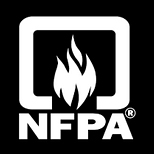 NO NEED TO CUT DOWN FORESTS TO PROTECT YOUR HOUSE FROM WILDFIRE.
NO NEED TO CUT DOWN FORESTS TO PROTECT YOUR HOUSE FROM WILDFIRE.
(NFPA: National Fire Protection Agency)
Instead, make your house “ignition resistant.”
READ FULL ARTICLE:
https://www.sierraclub.org/sierra/congress-trump-exploit-fire-tragedy-promote-logging-agenda
EXCERPT: The fires that occurred [Oct. 2017] in California were in low-elevation foothill ecosystems dominated by oak woodlands and grasslands…far away from any national forests or other federal public lands. Eviscerating environmental laws on federal forestlands would do nothing whatsoever to help the affected communities now or in the future. Instead, what the tens of millions of Americans living in rural communities within fire-adapted ecosystems really need is for federal and state lawmakers to focus on directly protecting homes and lives from wildland fire.
The science is clear on how best to do this, and it involves a few basic steps. Most important, we need to help homeowners make their homes far more fire-safe. This includes measures such as using fire-resistant roofing and siding, installing rain gutter guards (to prevent flaming embers from landing in a dry bed of pine needles and leaves accumulating in rain gutters); using a fine-wire mesh on exterior vents to prevent embers from floating into interior spaces like attics; and replacing wood decks with fire-resistant composites. Homeowners also need assistance to create “defensible space” within 60 to 100 feet around their homes, which involves removing most small trees and shrubs, removing lower limbs on mature trees, and annually raking up and removing small twigs, needles, and leaves from the ground. (Clearing vegetation away from larger distances from homes offers no added benefit for home protection, research shows.)
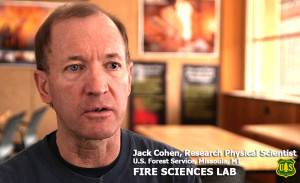 Dr. Jack Cohen, Fire Science Researcher with the USDA Forest Service Fire Lib in Missoula, MT, explains current research on how homes ignite during wildfires, and precautions homeowners can take so their house can survive flames and embers.
Dr. Jack Cohen, Fire Science Researcher with the USDA Forest Service Fire Lib in Missoula, MT, explains current research on how homes ignite during wildfires, and precautions homeowners can take so their house can survive flames and embers.
EDUCATIONAL WILDFIRE VIDEOS:
1) “Wildfire! Preventing Home Ignitions” – An introduction by Jack Cohen
2) Wildfires are inevitable but house fires are NOT. U.S. Forest Service FIRE LAB research shows why:
3) Introduction to Jack Cohen, Physical Research Scientist at U.S. Forest Service FIRE LAB, Missoula, MT: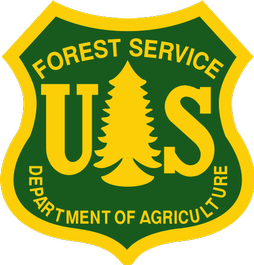 The U.S. Forest Service explains why cutting down eucalyptus forests in Oakland and Berkeley, CA hillsides INCREASES fire danger. Sept. 27, 2013 assessment of a SF Bay Area deforestation plan proposed to reduce fire danger.
The U.S. Forest Service explains why cutting down eucalyptus forests in Oakland and Berkeley, CA hillsides INCREASES fire danger. Sept. 27, 2013 assessment of a SF Bay Area deforestation plan proposed to reduce fire danger.
EXCERPT:
“Removal of the eucalyptus overstory would reduce the amount of shading on surface fuels, increase the wind speeds to the forest floor, reduce the relative humidity at the forest floor, increase the fuel temperature, and reduce fuel moisture. These factors may increase the probability of ignition over current conditions.“ [Emphasis added – Ed.]
SPREADING FEAR of FIRE to kill trees, and cut down entire forests.
Step back for a moment to a more objective distance and ask yourself: since when have trees, of any species, anywhere, been considered so dangerous we must cut them down?
Fearing a forest because it might catch fire is a relatively modern phenomenon, only recently in human history, since so many of us stopped living in or even near forests — even though we are still dependent upon them for food, medicine, building materials, oxygen production, carbon sequestration, wild animal sanctuary, and much more READ HOW MUCH TREES DO FOR YOU.
In the case of eucalyptus trees in California, this fear of forests is whipped up by repeating non-scientific claims that eucalyptus are particularly flammable (!). There is no scientific (nor even empirical) basis for this claim, yet many people in California now believe it because it’s been repeated so often. And the list of imaginary tree hazards includes eucalyptus trees falling over easily, or crowding out other trees, or not supporting wildlife — myriad and exaggerated, even bizarre claims, without scientific substantiation, all part of a non-scientific smear campaign by so-called “native” plant extremists out to eradicate an entire tree species.
Simultaneously, the myriad benefits of this maligned tree are ignored. “Invasion Biology” which placees some species of plants (and animals) into simplified, overly broad categories of Good and Bad, often linked only to certain human migrations, yet not others. No scientific studies support these arguments, just hearsay, false generalized information — and years of repetition. READ MORE ABOUT INVASION BIOLOGY
IF EUCALYPTUS TREES in California WERE AS FLAMMABLE as claimed — even called “gasoline trees” by those who hate them — why has there not been one major California eucalyptus fire of supposedly “highly flammable” trees in 100 years?! The only fire, in fact, sometimes blamed on eucalyptus trees is the 1991 Oakland Hills fire, has been exonerated as NOT being the fault of eucalyptus trees in several official reports. READ THE REPORTS ON THIS PAGE.
FEAR CAN OVERRIDE REASON: An April 2015 study by California’s Chapman University, survey of 1,514 random American adults, found 8.5% have kenetimortophobia — a fear of zombies!
![]()
Since the likelihood of these people encountering a zombie is, uh, incredibly low, zombie fear exists for reasons for an imagined danger, not an actual one. Presumably from watching pop culture movies and TV shows of attacking zombies. So to, people who fear being killed in a eucalyptus-specific forest fire — or being harmed by so-called “invasive” plants or animals — are programmed by repetition of alarmist words and images (like of forest fires). READ THE Chapman University STUDY ON FEAR.
READ Jack’s blog, “Of eucalyptus trees and the zombie apocalypse”
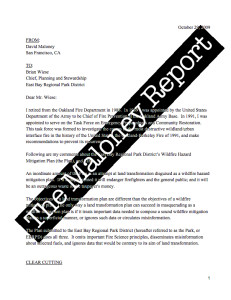 Logging increases fire danger.
Logging increases fire danger.
Read “The Maloney Report,” by David Maloney, the former Chief of Fire Prevention at The Oakland Army Base.
The National Fire Protection Association (NFPA) considers all living trees, no matter the species, more resistant to fire than grasses, shrubs, and dead, woody materials on the ground. The NFPA does not draw distinctions between “native” and “non-native” species. Learn how forests act to SUPPRESS fires in many ways. READ REPORT.
![]() Logging California’s dead trees is harmful to the forests. By Chad Hanson & Dominick A. Della Salla.
Logging California’s dead trees is harmful to the forests. By Chad Hanson & Dominick A. Della Salla.
The logging industry and some members of Congress have been spreading misinformation and fear of fire about dead trees in California’s forests in order to promote a weakening of environmental laws and increased logging on national forests. Dead trees are not an end to a forest but are part of the renewal cycle of life and death that rejuvenates forest ecosystems.
Chad Hanson is an ecologist, and director of The John Muir Project, a project of Earth Island Institute. He holds a Ph.D. from UC Davis in ecology.
His field research focuses on forests and fire ecology, especially in California.
 “Logging damages an ecosystem”
“Logging damages an ecosystem”
Article by George Wuerthner: http://www.thewildlifenews.com/2016/01/13/how-much-ice-is-right-collaboratives-and-forest-ecosystems
Forests do not need to be “fixed” or “restored” as they are perfectly capable of “restoring” themselves, if indeed, one even agrees that they “need” restoration—an assumption I would question in most instances.
“Bloodletting and wildfires”
Article by George Wuerthner: http://www.thewildlifenews.com/2018/10/22/blood-letting-and-wildfires
People are desperate to curtail the smoke, fires, and inconvenient created by wildfire so they grasp at anything that promises a “cure. The common refrain we hear over and over is that if we only “actively managed” forests to reduce fuels we would “cure” the perceived smoke and fire problem.
 George Wuerthner is an author, activist, photographer who has published more than 30 books on America’s wild places, including Wildfire: A Century of Failed Forest Policy
George Wuerthner is an author, activist, photographer who has published more than 30 books on America’s wild places, including Wildfire: A Century of Failed Forest Policy
Experts in the field of fire science — as opposed to “vegetation management” personnel who lack firefighting training — know living trees are not a major fire danger. Dead woody materials, dry brush and grasses ARE because they ignite more easily.
WE LIVE IN AN ERA OF HUMAN-CAUSED CLIMATE CHANGE. 97% of the world’s climate scientists agree on this critical conclusion, as does the overwhelming majority of scientific literature. See the overwhelming evidence on NASA’s Global Climate Change consortium: http://climate.nasa.gov/scientific-consensus
See the overwhelming evidence on NASA’s Global Climate Change consortium: http://climate.nasa.gov/scientific-consensus
CLIMATE CHANGE IS CAUSED IN LARGE PART BY DEFORESTATION, so we desperately need more trees, not fewer, everywhere, not just in tropical rainforests. Trees cool the earth by creating shade, sequester atmospheric carbon, produce oxygen, and also stabilize the East Bay’s steep hillsides and create precious wildlife habitat. Yet about one-half million vital, healthy trees are about to be destroyed. And in the past few years, tens of thousands of healthy SF Bay Area trees have already been killed in similar, smaller clearcuts. WHY?
1st FALSE ALARM: “FIRE DANGER”
The flammability of specific species of trees has been systemically fabricated and exaggerated, for years. You may have heard some of this, and even assumed it must be at least partially true. But it isn’t. This is simply, and terrifyingly, extremists in the “native plant” movement’s most effective tool to get media attention, and frighten and influence the public, and policy.
Think of this: there are literally millions of eucalyptus trees in the state of California. They have been here well over 100 years (some over 150 years). If this many trees are so “dangerously flammable,” why has there not been one single big eucalyptus tree fire?
The only fire now often, erroneously, blamed on eucalyptus trees was the 1991 Oakland hills fire — but numerous official reports debunk this claim. They detail how that was a grasses and brush fire that ignited houses and then trees of all species. So of course eucalyptus trees burned and threw embers — as did redwoods and pines and all trees. All trees burn in a big fire, and any trees with resins and oils (pines, redwoods, bays) can “explode.” Houses, which are drier and burn hotter than any trees, threw more and larger embers — and, for example, burning 2x4s — into the air to spread that catastrophic fire.
CRITICAL POINT WORTH REPEATING: The 1991 Oakland hills fire began in grasses and shrubs, and then ignited houses. Eucalyptus trees were NOT responsible for its start— although today they are routinely blamed/scapegoated. Eucalyptus, like redwoods, bays and oaks all burned of course, but human error had much more to do with that fire catastrophic result — and all this is detailed in several official reports on that fire. (READ MORE about all this below, under “1st FALSE ALARM: FIRE DANGER”)
 FEMA’s own 1991 report, 120 pages long, and 2) the Oakland and Berkeley Mayor’s Task Force report, and 3) a report by the former Oakland Army Base’s Chief of Fire Prevention who was so outraged by “nativists” scapegoating trees to achieve aesthetic eradication efforts, he issued “The Maloney Report.”
FEMA’s own 1991 report, 120 pages long, and 2) the Oakland and Berkeley Mayor’s Task Force report, and 3) a report by the former Oakland Army Base’s Chief of Fire Prevention who was so outraged by “nativists” scapegoating trees to achieve aesthetic eradication efforts, he issued “The Maloney Report.”
READ the official Oct. 1991 FEMA report’s recommendations to reduce fire danger in its “LESSONS LEARNED” page (69) summary: CLICK HERE
In fact, so-called “native” plant advocates have cut down TENS OF THOUSANDS of healthy, mature trees of several species over the past decades — ultimately en route to killing MILLIONS of healthy trees. This ignores climate science and the significance of the huge amounts of carbon all species of trees sequester. To ignore science and common sense and convince the public massive deforestation is necessary, “nativists” must find a reasons compelling than species preference and romantic visions of a long ago landscape.
Yelling “Fire!” loudly and often works, and can, over time, convince people they are in danger…from Monterey Pine, acacia and especially eucalyptus trees. Perhaps you’ve heard or read, “somewhere,” that “eucalyptus are highly flammable?… Which leads to The 450,000-tree Question…
ARE EUCALYPTUS TREES, IN FACT, HIGHLY FLAMMABLE?
The photo above shows eucalyptus trees are not the “highly flammable“ threat “nativists” repeatedly claim they are in order to spread fear and advance a species-eradication agenda. In 2003, a large fire consumed much of Scripps Ranch in San Diego — but left many eucalyptus trees unburned. If eucalyptus were as flammable as reputed, how can this be?
Scripps Ranch is just one of many such examples. Why is the onus on those defending an entire species of oxygen-producing, carbon-sequestering, shade-making, globally cooling tree, anyway? Why don’t people demand proof from those demonizing literally MILLIONS of trees scientific proof of danger instead of only heresay that any living, green, water-filled tree is “flammable” and “hazardous” and as claimed?
The question must be asked repeatedly, until more people delve into both the question and the answer, “How did ANY tree become an enemy, something to fear and to kill?” The short answer is: “Invasion Biology” – CLICK TO LEARN WHY.
• Angel Island’s (SF Bay) biggest recorded fire occurs only AFTER cutting down eucalyptus tree canopies. This fire science textbook-worthy example of how trees of all species provide cooling shade, suppressing the growth of low-growing, more flammable “native” grasses and brush occured in Oct. 2008 after years of systematic forest destruction.
Eucalyptus trees’ thick, water-filled, fire-resistant trunks resist burning in grass and shrub fires like this one. Of course, nativists, unceasingly determined to eradicate certain species of trees they don’t like, ignoring contradictory evidence, argue that trees would have burned too — even though the fire stopped at the base of the few eucalyptus trees not cut down.
READ MORE: HCN blog
• “A fast-moving brush fire atop Angel Island shot flames high into the air…”: SF Chronicle 10.13.08
• READ MORE EXAMPLES of eucalyptus trees NOT burning in fires: http://milliontrees.me/2010/11/14/trees-withstand-the-firestorm
Did you know that “native” California Bay Laurel trees contain twice as much volatile oil as “non-native” eucalyptus trees? (Hence the characteristic pungent odor of a torn bay leaf.) And because bay trees grow closer to the ground than blue gum eucalyptus, bay trees are more likely than eucalypts to be ignited by grassland and shrub fires typical in the East Bay hills. This fact is ignored by “nativists” who fan the flames of fire fear in the public in order to advance their agenda of “non-native” species eradication.
Did you know that the fire science guiding firefighters — note distinction from “vegetation management” workers — does not distinguish between species of trees, and considers all living trees, because of their high moisture content, are considered resistant to fire?
• READ the former Chief of Fire Prevention at Oakland Air Force Base, David Maloney’s, blistering critique of the clearcut plan (East Bay Regional Parks District’s portion).Maloney also served on the Task Force on Emergency Preparedness & Community Restoration formed to investigate causes of the 1991 Oakland-Berkeley Hills Fire — and prevent its recurrence. CLICK HERE TO READ REPORT.
EXCERPTS:
Some people have it backwards. They want to give a high fire hazard rating to green (living) trees and cut them down, because they did not originate in California, when it has been shown over and over again that green trees, regardless of where they originated, are a bulwark against wildfire because of the moisture they contribute to the ground fuels and because they act as windbreaks.
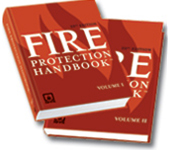 Nowhere in the twenty editions and tens of thousands of pages of the Fire Protection Handbook is there a mention of the leaves or bark of the Eucalyptus trees. The only aerial fuel singled out for mention because of its high flammability and volatility are the needles of coniferous trees. The oils and resins of Eucalyptus leaves and barks are not mentioned because they are not as flammable as the oils and resins of the needles of coniferous trees. [The Fire Protection Handbook is published by the National Fire Protection Association – Editor]
Nowhere in the twenty editions and tens of thousands of pages of the Fire Protection Handbook is there a mention of the leaves or bark of the Eucalyptus trees. The only aerial fuel singled out for mention because of its high flammability and volatility are the needles of coniferous trees. The oils and resins of Eucalyptus leaves and barks are not mentioned because they are not as flammable as the oils and resins of the needles of coniferous trees. [The Fire Protection Handbook is published by the National Fire Protection Association – Editor]
If the leaves and bark of Eucalyptus trees were more of a fire hazard than the thousands of other species of trees that are in California it would be noted in the Fire Protection Handbook.
• CLICK TO READ FULL “Maloney Report,” HERE.
READ FIRE ARTICLES, LEARN FIRE SCIENCE
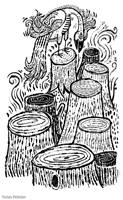 • READ New York Times Op-Ed, “More Logging Won’t Stop Wildfires,” by ecologists Chad Hanson, Ph.D. and Dominick A. Dellasala, Ph.D, another opinion and explanation, perhaps counter-intuitively for you, why cutting down forests doesn’t make us safer from wildfire: http://www.nytimes.com/2015/07/23/opinion/more-logging-wont-stop-wildfires.html?_r=1
• READ New York Times Op-Ed, “More Logging Won’t Stop Wildfires,” by ecologists Chad Hanson, Ph.D. and Dominick A. Dellasala, Ph.D, another opinion and explanation, perhaps counter-intuitively for you, why cutting down forests doesn’t make us safer from wildfire: http://www.nytimes.com/2015/07/23/opinion/more-logging-wont-stop-wildfires.html?_r=1
EXCERPT:
Just as they did in 2013, supporters of this legislation are using the public’s fear of forest fires to advance their agenda. They argue that overgrown and “unhealthy” forests raise the risk of wildfires, and that the government has been hampered by litigation and environmental reviews from allowing timber companies to thin forests to reduce the risk of fire.
Chad Hanson VIDEO: Chad Hanson explains why NOT to log after a forest fire — it increases future fires and does ecological harm, including to wildlife. (It’s often driven by timber industry profits, as well as U.S. Forest Service profit, as the USFS derives its operating budget from so-called “salvage” logging to timber industry, a systemic conflict of interest.)
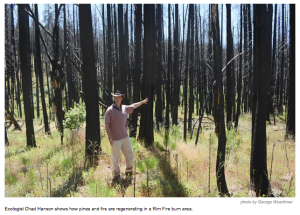 READ “The War Against Wildire,” by George Wuerthner: http://www.earthisland.org/journal/index.php/eij/article/the_war_against_wildfire
READ “The War Against Wildire,” by George Wuerthner: http://www.earthisland.org/journal/index.php/eij/article/the_war_against_wildfire
EXCERPTS:
…for nearly a century now, the US Forest Service has been waging a war against wildfires in the West, spending billions of dollars to put out fires on public lands and supporting commercial logging projects to thin out forests in order to prevent fires from spreading and “destroying” the forestlands. …despite the overwhelming body of new research that points to its futility as a fire retardant as well as to the immense ecological harm it causes…
Rather than reduce a wildfire’s reach, thinning can sometimes actually increase a fires spread by putting more fine fuels like needles and cones on the ground and opening up the forest canopy, which in turn dries out these fuels and allows greater wind penetration. It is fuels like needles, grasses, and shrubs that sustain blazes.
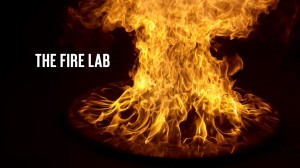 • READ “Reducing the Wildland Fire Threat to Homes,” by Jack Cohen: CLICK HERE
• READ “Reducing the Wildland Fire Threat to Homes,” by Jack Cohen: CLICK HERE
Jack D. Cohen is a Research Physical Fire Scientist with the USDA Forest Service Missoula Fire Sciences Laboratory in Missoula, MT. Cohen is the pre-eminent researcher on wildfire and home ignitions, and a founder of the Firewise Communities/USA recognition program. Jack crystallized the concept and coined the phrase “Home Ignition Zone” which is how we can protect houses and structure without cutting down forests out of misplaced fears.
• VIDEO: Jack Cohen, Research Physical Scientist, U.S. Forest Service FIRE SCIENCES LAB, Missoula, MT:
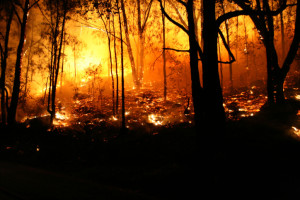 • READ “Study finds logging increased intensity of Black Saturday fires” (of Australia, Feb, 2009), CLICK HERE.
• READ “Study finds logging increased intensity of Black Saturday fires” (of Australia, Feb, 2009), CLICK HERE.
EXCERPTS:
In a landmark two-year study of the Kilmore East and Murrindindi Mill fires, which destroyed Marysville and severely damaged Kinglake, scientists from Melbourne University and the ANU examined satellite images of hundreds of thousands of trees burnt on Black Saturday. The scientists say the study showed conclusively that logging in the decades prior to Black Saturday made the deadly blaze much more extreme.
The scientists believe the increased fire risk in logged areas is due to several factors. Regrowth forests have more trees packed more closely together and contain large amounts of flash fuels allowing fire to build in severity, the study found. Old-growth forests usually have wet rainforest understorey canopies, which do not burn as well as the drier understory canopies of regrowth forests.
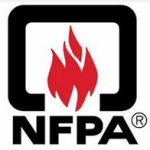 • READ NFPA (Nat’l Fire Protection Association) tips for Wildfire Preparedness. This is done without cutting down forests, which only increases fire danger by destroying forest wind breaks and cooling canopies and moisture-collecting properties: http://firewise.org/wildfire-preparedness.aspx
• READ NFPA (Nat’l Fire Protection Association) tips for Wildfire Preparedness. This is done without cutting down forests, which only increases fire danger by destroying forest wind breaks and cooling canopies and moisture-collecting properties: http://firewise.org/wildfire-preparedness.aspx
 • READ George Wuerthner, wildlife biologist, botanist on protecting houses from wildfire by making them fire resistant and creating defensible areas around them, NOT thinning forests: CLICK HERE
• READ George Wuerthner, wildlife biologist, botanist on protecting houses from wildfire by making them fire resistant and creating defensible areas around them, NOT thinning forests: CLICK HERE
• READ George Wuerthner: “Fire Fighting Wastes Money”: http://www.thewildlifenews.com/2015/08/17/fire-fighting-wastes-money
The solution is not to give more money for fire fighting–it will just be wasted on useless attempts to control fires. By far the best solution is to zone people from building in fire plains and to create defensible spaces around homes.
• READ George Wuerthner’s, “Wilderness Advocates Must Address Wildfire Misinformation”: http://www.thewildlifenews.com/2015/12/03/wilderness-advocates-must-address-wildfire-misinformation
And unfortunately conservation organizations have not invested enough time and energy in countering the misinformation and educating the public about what constitutes a healthy forest ecosystem (hint: a healthy forest ecosystem has lots of bugs, disease and fire) and why common prescriptions like thinning are unlikely to preclude large fires.
• USE GOATS (!) TO TRIM GRASSES and reduce fire danger. Grasses and brush and shrubs are far more ignition-prone than than ANY tree species. All fire experts and fire science (see articles above and more below) explain this. Grasses should be kept trimmed to reduce fire danger. Grasses are what started and rapidly spread the 1991 Hills fire, not eucalyptus trees.
Herds of goats are less expensive and far less toxic than herbicides the clearcutting plan (and the Sierra Club!) endorses, and far less dangerous than prescribed burns. And they’ve already been used in the East Bay hills for exactly this purpose! Why are they not now being recommended for fire danger mitigation work? Is it because there is more profit in using Monsanto and Dow Chemical company products? Is it because those who wish to eradicate eucalyptus trees want to keep the focus on them, and not other, more effective and reasonable treatments?
READ ABOUT GOATS: http://www.dailycal.org/2014/07/22/goats-back-berkeley-act-eco-friendly-lawn-mowers
CHECK OUT family-owned business “Goats R Us”: http://www.goatsrus.com
2nd FALSE ALARM: “INVASIVENESS” or… KILL THE INVADERS, KILL THEM ALL – Invasion Biology
Tragically, some “native” plant proponents perpetuate and popularize myths, misconceptions and monster stories about certain species of living, moist, fog-capturing trees, especially demonizing eucalyptus trees. These tall tales, repeated for years, become popularized, like Donald Trump’s picking on Mexicans and Muslims, and become justifications to enforce the aesthetic biases — and then advocating…cutting them all down. (Like tossing out entire ethnic, cultural or religious groups out of the U.S. because “we all know they’re bad, dangerous, you-name-it.”
YELL “Fire!” IN A CROWDED FOREST TO SPUR CLEARCUTS
Living forests, including eucalyptus forests, are LESS likely to burn than the East Bay hill’s grasses and dry chaparral shrubs like coyote brush that “nativists” prefer and would cut down forests in an attempt to recreate. These smaller plants ARE extremely flammable in the dry season compared to large eucalyptus trunks that hold far more water and are thus comparatively fire resistant. NOTE: The infamous 1991 Oakland Hills fire was ignited by grasses and brush — not trees — then spread to houses, which burn hotter than any trees. Only then did trees of ALL species ignite.
READ “Trees Withstand the Firestorm”: http://milliontrees.me/2010/11/14/trees-withstand-the-firestorm
READ MORE: http://sutroforest.com/eucalyptus-myths/native-plants-are-more-fire-prone-than-eucalyptus In contrast with dry chaparral, East Bay eucalyptus forests create cooling shade, and annually produce 10″ of fog drip rainfall, especially in the hot, otherwise dry summer months.
Stripping away tens and hundreds of thousands of trees will leave the land hotter, drier, and MORE prone to fires of existing grasses and low vegetation. Eucalyptus trees are often condemned for having volatile oils in their leaves (they don’t have oils in their stout, fire-resistant trunks). The “nativists” won’t mention other Bay Area (“native”) species, like California bay laurel and coyote brush that also contain volatile oils in their leaves. In fact these “native” plants burn more readily than eucs because they grow closer to the ground than eucalyptus, thus igniting more easily from common grass and brush fires.
• READ MORE “NATIVES-ARE-FIRE-PRONE” MYTHS: http://sutroforest.com/eucalyptus-myths/native-plants-are-more-fire-prone-than-eucalyptus
CREATING A FIRE HAZARD BY CUTTING DOWN FORESTS: After clear cutting, the trees will be chipped and left on the ground. Thousands of cubic yards of dead, drying wood chips will BECOME the fire hazard proponents claim to be cutting down forests to prevent. This is hard to believe, but it’s the plan. It only makes sense if the actual agenda is eradication of all trees of certain species, not reducing fire risk.
THE 1991 OAKLAND HILLS FIRE is often falsely blamed on eucalyptus trees. That terrible blaze roared out of control and destroyed houses and killed people — but eucalyptus were NOT the cause — lack of preparedness and planning was. This included: 1) inadequate radio communications between different agencies; 2) pumps running out of water soon into the fire fighting; 3) fire trucks unable to access narrow streets; 4) non-universal hydrant hookups; 5) wood houses with wood roofs that turned the fire into a conflagration (bigger and much hotter).
![]() • READ October 1991 FEMA REPORT (Federal Emergency Management Agency) that determined a host of factors contributed to the disaster: http://www.usfa.fema.gov/downloads/pdf/publications/tr-060.pdf
• READ October 1991 FEMA REPORT (Federal Emergency Management Agency) that determined a host of factors contributed to the disaster: http://www.usfa.fema.gov/downloads/pdf/publications/tr-060.pdf
• READ Oakland Local article by Laura McCamy with comments by retired Oakland firefighter David Maloney who served on the Task Force on Emergency Preparedness & Community Restoration after the 1991 Oakland Hills fire.
He [Oakland firefighter David Maloney] called the EIS “a land transformation plan which is masquerading as a fire hazard reduction plan,” adding, “It stands fire science on its head.” Maloney noted that, in the Oakland Hills fire, “the radiant heat from the houses caught the trees on fire,” not the other way around.
Most people don’t know that a (“native”) grass fire, not completely extinguished the Saturday before, re-ignited and started the blaze. Valiant firefighters had a tough fight on their hands, with high winds, steep slopes and poor accessibility. The money spent on this deforestation plan would be better spent on improved fire preparedness in the many ways listed above and in the 1991 FEMA report.
READ ABOUT the 1991 Oakland Hills fire & its cause:
• “Remembering the Oakland Firestorm”: http://www.nbcbayarea.com/news/local/Remembering-the-Oakland-Firestorm-132282138.html
• Oakland Hills Fire Survivor Remembers Conflagration that took his mother: http://oaklandlocal.com/2013/06/oakland-hills-fire-survivor-remembers-conflagration-that-took-his-mother
• LEARN MORE about the 1991 Oakland Hills fire on SutroForest.com.
er, not a problem. Tragically, human fear and ignorance are the problem, as in evidence here. And the stakes have been raised to…
To adapt the trenchant words of a famous killer of humans:
“One death is a tragedy. The death of millions is a statistic.” – Joseph Stalin
Can you even picture 450,000 trees being cut down? Are you willing to experience just one? People who casually advocate for the destruction of hundreds of thousands, even millions of trees — including many who call themselves environmentalists — toss out huge numbers (if they talk numbers at all) and “removing” trees, devoid of emotion. And of course it must be this way. To be willing to be feel the actual, present-moment world in which trees and birds and animals live (and humans when they’re not lost in thought), you must be willing to be in touch with your own feelings. If you do sense that a tree, and an entire forest is alive, then it’s a very different experience to watch just one tree being chainsawed to its death.
We humans are interconnected with trees in an ancient web of life. We have been for millennia. The species doesn’t matter; if it’s a weathered oak, or a stout, 100-year-old eucalyptus, or a Monterey pine or cypress that has danced in more windy days than any human ever will. Be quiet and still on the inside, and tune in as its centuries of life are ended in minutes. Bureaucrats call these killings “removals,” even “hazardous fuels reduction,” either to hide the feeling of it, or simply because they can’t (i.e., choose not to) feel it. Maybe some people labeled it “bad” or “hazardous,” or the “wrong” type of tree. If you allow yourself to feel such things, then lobbying for the slaughter of hundreds of thousands of healthy trees becomes a serious affair, approached with the solemnity of how we humans go to war.
![]()
 TreeSpirit’s Jack Gescheidt’s telephone conservations about the number of trees to be cut down is all about being hard to believe: http://www.berkeleydailyplanet.com/issue/2015-07-17/article
TreeSpirit’s Jack Gescheidt’s telephone conservations about the number of trees to be cut down is all about being hard to believe: http://www.berkeleydailyplanet.com/issue/2015-07-17/article
If you repeat a lie long enough it becomes real. Then the lie no longer exists and you’re left with is your version of the truth. – Irfan Master
WMDs Q&A – Weapons of Mass Deception
RUMOR: Doesn’t the oil in eucalyptus trees makes them more flammable than most trees, and “native” trees?
REALITY: NO. The leaves of “native” California Bay Laurels and coyote brush also contain volatile oils that make them equally or even more flammable than eucalyptus leaves. But since they are “native,” nativists don’t target them for destruction by labeling them dangerously flammable. And since bay trees grow much closer to the ground than eucalyptus, their leaves are more likely to ignite in ground fires common in the Bay Area. (As opposed to crown fires in tree tops caused by lightning strikes common in, e.g., the Sierra Mts.). In fact, eucalyptus trunks are more dense and fire resistant than those of bays or oaks.
RUMOR: But what about eucalyptus tree bark litter — isn’t it a fire hazard?
REALITY: No simple yes or no answer here. Some alternate fire mitigation plans (to cutting down entire forests) are to remove (rake or burn or “goat”) bark litter out. This is less expensive than cutting down hundreds of thousands of trees and then twice every year, for ten years, applying carcinogenic herbicides — the current plan, believe it not it’s true. This will reduce the ground fuels load.
But removing all understory vegetation leaves the ground exposed so it won’t hold as much winter rain or summer fog drip, and therefore dries out — which makes ground fires more likely. NOTE: If you cut down the trees to end leaf and bark litter forever, then fast-growing, opportunistic plants like thistle, broom and poison oak will fill the void — and become their own fire hazard. Eucalyptus forest canopies, like all tree canopies, help suppress the growth of other, more flammable plants.
NOTE ALSO: Fire authorities don’t consider ANY living tree species a fire hazard necessitating destruction. Nor “ground fuels” Forests retain moisture beneath their canopies and within their trunks and are therefore considered.
“Fire Science has proven that every living tree — regardless of its species — due to its moisture content and canopy coverage of ground fuels, contributes to wildfire hazard mitigation.” – David Maloney, Chief of Fire Prevention, Oakland Army Base
 READ firefighter David Maloney’s FULL REPORT on eucalyptus trees in the East Bay hills and how the plan to cut down East Bay forests will INCREASE fire danger. Healthy, dense, green forests of ANY species are living, green plants that don’t burn as readily as dead materials — like wood chips and logs the clearcut plan would create and leave on the ground in abundance. The thick water-filled trunks of eucalyptus trees are, compared to these dead ground fuels, fire-resistant.
READ firefighter David Maloney’s FULL REPORT on eucalyptus trees in the East Bay hills and how the plan to cut down East Bay forests will INCREASE fire danger. Healthy, dense, green forests of ANY species are living, green plants that don’t burn as readily as dead materials — like wood chips and logs the clearcut plan would create and leave on the ground in abundance. The thick water-filled trunks of eucalyptus trees are, compared to these dead ground fuels, fire-resistant.
And the East Bay’s eucalyptus forests capture fog and create 10″ of rain-drip fog each year, particularly significant in the dry summer months. Their forest canopy shades the earth, thus cooling it, and take the place of dry grasses which are what caused the 1991 fire and currently (summer 2015) creating wildfires all over California. Living eucalyptus trees stabilize steep hillsides, and create bird and animal habitat, too.
NOTE AGAIN: The deforestation plan will NOT remove any wood from the hills, only turn it from wet, living wood (trees!) into dry, dead brush, chips, and logs left on the gorund (not removed from the hillsides), thus increasing fire danger.
These disturbing facts point to the actual goal of the clearcutting driven by the “native” plant agenda of species eradication, not fire risk reduction. READ MORE on “Invasion Biology” page.
RUMOR: But I’ve heard firefighters and other fire experts say eucalyptus are dangerous, flammable and should all be removed.
REALITY: Some do and some don’t. Many don’t draw distinctions between tree species, degrees of flammability, and fuel loads. Its complex and not, uh, clearcut.
“Native” bay trees and “native” coyote brush also contain flammable oils, as eucalypts do, and arguably more likely to ignite in the grass fires common in the Bay Area, because they grow closer to the ground. Bay Area fire marshals know that ALL living, green trees are NOT fire hazards — only dead materials are.
The best fire defense is simpler: cut defensible areas around houses and buildings, from 30-100 feet, depending on the structure, the trees, the wind, the forest, etc. And if you really fear forest fire, why live next to them? Or at least be consistent and advocate cutting down all trees, not just species targeted by the nativists. Nativists fan fire fears to leverage their species-specific extermination agenda.
The nativists, and also the agencies promoting cutting thousands of acres of trees, also repeatedly avoid discussion of the huge numbers of trees the plan will fell. They also ignore the massive amounts of carbon stored in these forests that would be released into the atmosphere. The 1991 Berkeley Hills fire — so often falsely blamed on eucalpytus trees — raged out of control for these human reasons. This isn’t as simplistic as demonizing eucalypts as dangerous invaders — but it’s true.
READ MORE about the 1991 fire and its causes.
RUMOR: But I’ve heard that eucalyptus trees were responsible for that 1991 Berkeley Hills fire that destroyed homes and took lives.
REALITY: It’s not true. Eucalyptus weren’t the origin of the fire. In fact, it burned the day before, on Saturday, Oct 19th, in dry brush, grass and (“native”) scrub oak on a steep slope above Buckingham Blvd. After being extinguished by firefighters, the next day, Sunday, Oct. 20th, the fire restarted as flare-ups in dry brush within and just beyond the burned area. It then spread into oak trees and houses which burn hotter than any trees. By the time flames reached the first grove of eucalyptus (1/6 mile away, just above Charing Cross), the fire was no longer just vegetation; it was a higher-temperature, structure-fueled conflagration that consumed everything in its path.
LEARN HOW & WHY the 1991 fire is blamed on eucalyptus to advance the native plant agenda.
RUMOR: But isn’t cutting down hundreds of thousands of trees the way to be safest from fire? Forests burn, right?
REALITY: NO, and yes. The plan for the Oakland and Berkeley Hills is to leave all the wood on the hillsides as acres of mulched trees — wood chips — in piles up to 2 feet deep. That’s it. These will dry out and become their own flammable hazard. Millions of pounds of drying, oily and now DEAD, combustible wood is not only more flammable than a living, green, wet forest, but also, obviously, far less desirable. These forests create shade, produce oxygen, and make water: creating an annual average 10″ of fog drip in the dry CA summer. The eucalyptus forests provide animal habitat. And the steep hillsides, without trees, will more likely collapse when there IS rain. Picture West Virginia coal mining landscapes. To contemplate a plan this extensive, destructive and drastic only shows how out of touch with nature’s living systems we’ve become, how driven by fear and aesthetic (“native plant”) agendas.
 RUMOR: I heard that eucalyptus trees harm birds, even kill hummingbirds by “gumming up” their beaks and suffocating them.
RUMOR: I heard that eucalyptus trees harm birds, even kill hummingbirds by “gumming up” their beaks and suffocating them.
REALITY: Once people have decided eucalyptus trees are monstrous, they search for — and create — myriad ways to demonize them. It would be laughable if it weren’t so destructive. There is no end to the tales being told, and repeated, and via repetition believed. READ how this especially nasty and bizarre “bird-killer” rumor, now perceived by many as factual, got started and spread, on Million Trees.me. CLICK HERE
RUMOR: So what’s the alternative to clearcutting to be safer from forest fires?
REALITY: A simpler, less expensive one, better for humans, animals, and our environment: a) more fire hydrants at edges of forests and communities; b) all hydrants with universal hook-ups; c) better, faster fire response planning; d) better communications; e) making defensible areas around structures. Had these systems and strategies been in place in 1991, the blaze would not have done the damage it did. LEARN MORE.
Again, the only 100% fireproofing solution is to cut down ALL the trees, and ALL the shrubs, and ALL the grasses on ALL the hills and PAVE EVERYTHING. Then there is nothing left to burn. No one advocates this plan because it is extreme to the point of absurdity. But so is cutting down 1/2-million healthy, green trees that shade and cool the earth, stabilize steep hillside in the East Bay hills, and sustain us and our environment, especially now in our era of human-caused global warming.
What’s become of us as a society that we can even conceive of deforestation projects this environmentally devastating? Have we learned nothing since Rachel Carson’s 1962 “Silent Spring” taught us the role nature plays in sustaining us, and its interconnected web of life? About our responsibility to be wise stewards of the land and ecosystems to which we are linked?
 READ NY Times Op-Ed: “More Logging Won’t Stop Wildfires” by Chad Hanson & Dominick A. Dellasala, July 23, 2015: http://www.nytimes.com/2015/07/23/opinion/more-logging-wont-stop-wildfires.html?_r=0
READ NY Times Op-Ed: “More Logging Won’t Stop Wildfires” by Chad Hanson & Dominick A. Dellasala, July 23, 2015: http://www.nytimes.com/2015/07/23/opinion/more-logging-wont-stop-wildfires.html?_r=0
ON THE EDGE OF FOREVER
Like never before in human history, we are on an edge of our own destruction — or salvation. Like never before, we need more green, life-giving forests of all kinds. One reason we’re in the environmental mess we’re in is because we’ve cut down so many of our forests — about 50% of what we homo sapiens started out with on Earth when we began our reign. We need forests ecologically, emotionally and spiritually — woodlands, parks and living, unpaved places, so WE feel alive and awake to the wonder and preciousness of our own aliveness, our own wild nature.
• SHARE THIS WEBPAGE and educate your friends and neighbors and acquaintances about wildfire and its necessity and importance in a healthy, natural ecosystem. We need not live in fear of it, and we need not try to prevent it from every occurring which is impossible anyway, unless we cut down all the world’s forests and pave over the Earth — in which case we will meet a fate far more harmful than wildfire.
THIS PAGE’S URL: https://treespiritproject.com/wildfire
• JOIN THE TreeSpirit EMAIL LIST to stay informed on this issue and related events:

